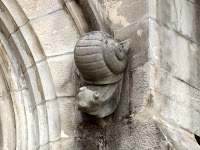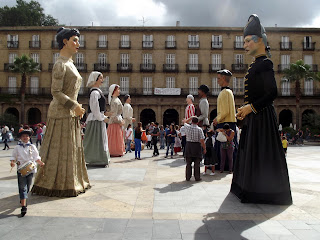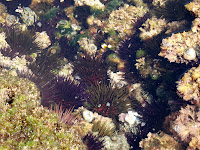Soon after Alexandra came Kate, an American like us. The Friday that she arrived, I was walking near Plaza Moyúa, and I saw a couple guys who looked very lost, so I asked where they wanted to go. Upon learning that we were heading in the same direction, we walked and talked. Before parting ways, I offered to show them around the city later that night, and they accepted. Later, I was looking on Couchsurfing, and there was a French girl who was looking for people to hang out with that night. So, that night, Bryan, Kate, and I met these two Americas, Jeff and Andrew, and the French girl, Helene, and we had some drinks and pintxos. The six of us then planned to get back together in the morning to go to San Juan de Gaztelugatxe, followed by the beach at Bakio. It turned out to be one of the best whims ever. Bryan gives me a hard time for being a human snowball, but so far it's been really rewarding. I always tell him that my sister Monica is worse than I am.
Between Couchsurfing events, I spent my time looking for places to live and people to give English lessons to. Unfortunately, no one was interested in English lessons in the summer. In August, most unessential businesses go on vacation, for the whole month! There were plenty of people looking for renters, but before visiting them, I talked with my friends Iban (from Álava) and Adrian (from Romania), and we decided that we'd look for a place to rent together. For me, this was ideal. I didn't want another experience of living without community like I had the year before. In the meantime, my friend Jessica, a fellow auxiliar, offered for me to rent her room while she was in the States because otherwise she'd be out a full month's rent. So, in August, I lived in Jessica's apartment and continued my search for more permanent housing, but it was difficult since all the real estate agencies were closed.
Since I still didn't have work, I continued to check Couchsurfing for travelers in need of guides and to meet people from all around the world at the weekly CS meetings. One day, I met up with Juan Carlos, from Guatemala, and Juan José, from Colombia, and we climbed Artxanda. Also, while I was looking for apartments, I met another Guatemalan, Stef, also a Couchsurfer. When I came to check out the apartment, she invited me to stay for a game of poker with her and some friends. She's one of the friendliest people I've ever met, with a knack for bringing people together, and I ended up coming back several more Fridays.
On another occasion, I saw a message from Nico, from Belgium. He was looking for people to hang out with in Bilbao, and he wanted to go hiking. We met one afternoon for drinks and pintxos. I remembered that there is a group called "sigue al burro" (follow the donkey) that goes hiking somewhere every Sunday, and this week they were going to Monte Candina in nearby Cantabria between Laredo and Castro-Urdiales. I told Nico about it and then decided to go myself. It also occurred to me that Alberto would be interested in going, so I invited him, too, and he brought his brother, Gabri. "Sigue el burro" was a fairly large group, over 15 Basque hikers. We made it to the top of the mountain and took in some amazing views of the Cantabrian coast, then we went to a place called "ojos del diablo" (Devil's eyes), a rock formation in the mountain with two large holes. Unfortunately, we hadn't brought our swimsuits with us, so the four of us decided to split away from the larger group to return to our car and then meet the others at the beach. We lost the trail and mistakenly went down the hillside of Hades. We'd run out of water, and it was hot. There were flies that kep biting us, and the descent was fairly steep and so overgrown with thorns that after over 30 minutes of trying to go downhill, we decided to backtrack (uptrack?) and find another way down. Eventually we did, and I'd never been more pleased to jump into the ocean, despite the salt water burning my scrapes.
 | ||
 |  |  |
Alberto, Nico, and I met up again for an excursion to the French Basque Country. First we went to Château Abbadia, near Hendaye, which is a cool little castle covered in stone statues of animals. Where is Aslan when you need him?
 |  |  |
 |  |
Then we went to our principal destination, Biarritz, a beautiful French coastal city. It was too cold to take a dip, so we just strolled around. Unfortunately, I think I unwittingly left my camera in the car when we were there, but I found the following pics on Nico's Facebook:
 |  |
 |
After seeing the main part of Biarritz, Alberto took us to a nearby peaceful lake, and we whiled away the hours. On the way back to Bilbao, Alberto took us to a small Basque village called Sare (or Sara in Basque). The town was having some sort of fair, and there was a flea market, music, cider, and talos. The picture on the left is in an old Basque cemetary. I thought it was really cool that so many of the headstones had a lauburu, symbol of Basque-itude.
 |  |
Another day, I met up with Alberto to see a parade, or so I thought. When I arrived at the metro stop, Alberto found me and took me into the parade, and I became a part of his parents' cuadrilla. I quickly learned their little dance, which resembled the dance I learned for The Wizard of Oz. I realized that was the reason Alberto wanted me to come, because I had recently taught it to him. So I danced down the hill with Alberto's parents while everyone watching the parade wondered what a guiri (foreigner) was doing in it. Later Alberto showed me the rest of the fiesta de San Roque in Portugalete, which was a nice precursor to the madness in Bilbao that I would experience later. There were an awkward rock band of men in thongs and people partying everywhere. We watched a cucaña competition in which young men had to grab a flag that was at the end of a greased pole before slipping into the river below. There was also a medieval market and a falconry show. Below is the jarrilla, icon of the fiestas of Portu. Apparently the doll has a different profession each year, and per custom, when the fiesta is over, they burn her.
On another occasion, Iban was participating in a tortilla (Spanish omelette) competition in Amurrio, and he invited me along. I arrived just as they were giving away awards, and Iban and his friends received some, but not as high as he would have liked. The photo top right is not a tortilla but bacalao al pil-pil, the signature dish of the Basque Country. There were also prizes for it. Afterward, I met Iban's friends, and we gorged ourselves on tortilla before playing a very confusing card game using a Spanish deck of cards.
| |||
|
The weekend after that, Couchsurfers in San Sebastian organized a hike in the cliffs of Jaizkibel, near the city of Hondarribia. About halfway through the hike, we stopped to swim and have lunch, though swimming was difficult due to the sharp rocks and urchins (or in Spanish "hedgehogs of the sea"). I met a lot of new people and had a great time. After the hike we had a snack in Hondarribia before finally heading home.
| |||
|
When I arrived from the hike, Aste Nagusia was already underway in Bilbao. Aste Nagusia, Basque for "big week," boasts Spain's longest party, nine days of free concerts, parades, bullfights, and Basque cultural events like rural sports, gastronomy, and dancing. A park that overlooks the city is converted for the week into a carnival similar to the state fair, complete with rides, junk food, games, and a circus. And an area along the river is lined with txosnas, stands that sell drinks and sometimes have live music. The most incredible thing was the volume of people. I don't know where they all came from or where they slept, but there they were. On two separate days, I saw a parade of giants.
 |  |
On another day, I went to a bullfight with Bryan and Juan Jose. I didn't understand exactly how the bullfighters were being ranked, so I can't explain how it works, but there seemed to be a ton of tradition involved, like a culture within a culture, much like in any sport, I suppose. I was impressed that there were so many dedicated spectators, despite changing cultural trends. The skill of the bullfighters was incredible, and I was mesmerized just as Hemingway must have been.
 |  |
Each night of Aste Nagusia, there is a fireworks show, and I watched every single one. Before seeing these fireworks, I had never really noticed the art involved in setting them off. Some of these shows are competitions, so they are taken very seriously. They don't just set them off randomly, but every explosion is timed and positioned where they want it. I had also never been so close to the fireworks show before, but in certain areas of the city, you could not only see, hear, and smell them, but also feel the vibrations.
 |  |  |
After the fireworks is when the real party is kindled each night, so afterwards, I usually got together with friends and enjoyed a concert or two. My favorite concert was an extremely talented Irish group that performed right next to the Guggenheim museum. Above in the middle, I'm with friends Juan Jose, Ozlem (from Turkey), and Noemi (from Bilbao). On one of the most memorable nights of the week, I taught them the hokie pokie. On the right, though she's hard to see, is Marijaia, symbol of Aste Nagusia. At the end of the fiestas, she is rowed down the river and burned in front of city hall.













































